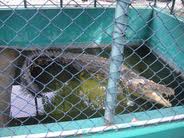Meet the famous Nile crocodile, whom we Maldivians call “Kinboo”. The cage pictured here, has been Kinboo’s home since it was caught 15 years ago on February 14.
The year, 1998, in which the Kinboo was caught in the Maldivian waters, I had just started school. The report of its capture brought a mixture of shock and delight.
Like everyone, both children and adults, I was curious to see a crocodile. After all, the famous predator is an alien species to the Maldive’s eco system. Before that day, the only crocodiles people had seen or heard were from movies and books. For me, it was the Peter Pan cartoon – the “tick tock” crocodile that wanted to eat villain Captain Hook is an all-time favorite of mine.
But all the pushing and fighting my way through to the front of the flock surrounding the cage on my visit to see the Kinboo turned out to be a big disappointment. Unlike I had imagined, Kinboo was so small that he was barely visible in the little enclosure built at the children’s park. The water at the enclosure completely covered it.
I struggled to get a glimpse and, before I could, was soon pushed back by the eager crowd. From what I overheard, Kinboo did not surface.
It was almost over decade later that I got to visit Kinboo for the second time. While living in Addu, I heard stories told by visitors from Male’ about how big the Kinboo had grown. But again, it was nothing like I expected. The sheer size of its growth left me in shock: “It is so big,” I said to my friends in bewilderment.
Once barely visible, Kinboo was now almost 10 feet long. The water in the cage barely covered its belly as it lay flat inside. Its long powerful tail was curled up to fit inside the roofed-cage that is no larger than 15 by10 feet. Pieces of papers and candy wrappers were scattered inside, most likely thrown by eager visitors in an attempt to get Kinboo’s attention.
Thinking of all those years of captivity disturbed me. After few more looks I went home like other visitors, but the thought of Kinboo’s miserable life never faded away.
“Free Kinboo” is of course not a new subject for a story, as some may have already thought whilst reading this article. Yes, I am guilty of bringing you old news.
Yes, I also know campaigns were started to “Free Kinboo” years ago. Kinboo even has its own Facebook page, calling for its immediate release, and bloggers have often repeated the lonesome story of Kinboo.
Children from Billabong High EPSS International school embarked on a mission to save the Kinboo in 2010 and for a moment it seemed that the Kinboo was finally going to be freed.
But the purpose of writing this piece is to remind readers that the mission failed. Kinboo continues to miss out on the world beyond the bars.
As we grow up, finish school, start jobs, cast votes and even witnessed three president’s in office – nothing has changed for Kinboo.
The life expectancy of a Nile crocodile in captivity can be up to 80 years. Will Kinboo still be in the same cage when we have retired or even passed away?
So now you may ask, “What can we do about that?”
Some may even respond,”There are more important issues like a coup to write about, rather than a dinosaur.” For the latter, I have a request. Put yourself in Kinboo’s shoes. But wait, Kinboo doesn’t have shoes, so I rephrase, put yourself in Kinboo’s cage for a moment. Now imagine that moment was 15 years.
What exactly can we do for the Kinboo?
Environment Protection Agency (EPA) Director General Ibrahim Naeem believes there are two options.
“The first option is to transfer the crocodile to a suitable zoo or wildlife park abroad, where it can be rehabilitated before being freed into the wild. Some efforts were made to rescue the crocodile. But it did not work for some reason,” Ibrahim Naeem explained.
During the Billabong School’s mission to save the Kinboo, the school’s former Biology Teacher, Kate Wilson, wrote to an international agency in Australia, which rescues crocodiles that are injured or in bad condition.
Unfortunately, she never heard back from the agency.
“If we cannot work out a plan to rescue the crocodile,” Naeem said, “it should be killed”.
“It is indeed time we do something about the crocodile. We cannot keep it caged forever. Either we should kill it or move it to zoo in a foreign country,” he said. “It is costly to move the crocodile abroad. But the state also bears expenses to feed and keep the crocodile alive in the enclosure. So we have to decide,” he added.
The Maldives National Defence Force (MNDF), which oversees the crocodile, also expressed their discontentment at the prospect of keeping the animal caged for life.
“We don’t want to keep the crocodile inside the cage. It is there because no decision has been made otherwise. If possible we want to see what options we have,” said MNDF media official Lieutenant Abdullah Mohamed.
Friends with whom I shared the idea of a “mercy killing” rejected it instantly, calling it “inhumane”.
But should we not take a moment to reconsider what exactly is inhumane. How long are we to keep a living creature behind those bars for mere entertainment? Five more years? Maybe 20? Or until it dies naturally?
So I ask, how human are we to cherish our freedom, while the crocodile lies in a cage until death sets it free? A wise man once said, all that is needed for evil to triumph is good men to do nothing. Letting the crocodile suffer in cage is wrong, if not evil. It is time the authorities must decide.
Either kill Kinboo or free it.
Likes (0)Dislikes
(0)Dislikes (0)
(0) 
